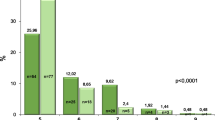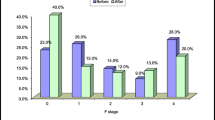Abstract:
The aim of this study was to evaluate the antifibrotic effect of interferon (IFN)-α in chronic hepatitis C (CH-C) patients with no response to IFN-α therapy. We studied 76 patients (46 men, 30 women; mean age, 55.6 years) who received IFN-α intramuscularly, at a total close of 480 to 880 MU for 6 months (group A). As a control group, we studied 50 patients (32 men and 18 women; mean age, 58.5 years) with CH-C who received medication other than IFN (ie, Strong-Neo-Minophagen C, ursodeoxycholic acid, and a herbal medicine, Sho-saiko-to [TJ-9]) and who had persistent alanine aminotransferase (ALT) elevation (group B). All patients were subdivided into three subgroups according to different patterns of ALT changes during the observation period, ie, (a) persistent ALT level < 60 IU/l (below about twice the upper limit of the normal range), (b) persistent ALT level ≥ 60 IU/l, (c) ALT levels other than (a) and (b). Liver biopsy was performed within 6 months prior to IFN therapy and more than 6 months after IFN therapy, while two liver biopsies were performed during therapy in group B. Liver fibrosis was compared between two specimens by staging. When the fibrosis stage was the same in the two specimens, we determined whether the fibrosis had improved or worsened by comparing the fibrotic ratio, ie, the ratio of the area of fibrosis to the area of the entire liver tissue specimen, calculated using computed graphic software. Serum aminoterminal peptide of type III procollagen (PIIIP) levels were measured on the day of the liver biopsy and their mean yearly changes were compared between the two groups. Improvement of liver fibrosis was found in 12% to 30% of patients in each ALT subgroup and in 24% of all patients in group A and there were no significant differences in liver fibrosis in comparison with findings in of group B when assessed by staging alone. However, these percentages rose to 59% to 75% and 66%, respectively, when liver fibrosis was assessed by the fibrotic ratio together with staging, resulting in a significant difference in fibrosis between groups A and B in total (P < 0.01). The mean yearly changes in serum PIIIP levels in each subgroup and in all patients in group A were below zero, indicating a tendency to improvement of fibrosis after IFN therapy, while these changes in group B were all above zero, except for subgroup (c). Improvement of fibrosis after IFN therapy was found in 15 of 24 patients (64%) whose ALT changes had the same pattern before and after IFN therapy, although no significant difference was noted between improved and worsened patients. These results suggest that IFN-α may have an antifibrotic effect even in CH-C patients with no overt response to IFN-α therapy, compared with the effect of medications other than IFN.<
Similar content being viewed by others
Author information
Authors and Affiliations
Additional information
Received: January 27, 1999 / Accepted: June 25, 1999
Rights and permissions
About this article
Cite this article
Yagura, M., Murai, S., Kojima, H. et al. Changes of liver fibrosis in chronic hepatitis C patients with no response to interferon-α therapy: including quantitative assessment by a morphometric method. J Gastroenterol 35, 105–111 (2000). https://doi.org/10.1007/s005350050022
Issue Date:
DOI: https://doi.org/10.1007/s005350050022




